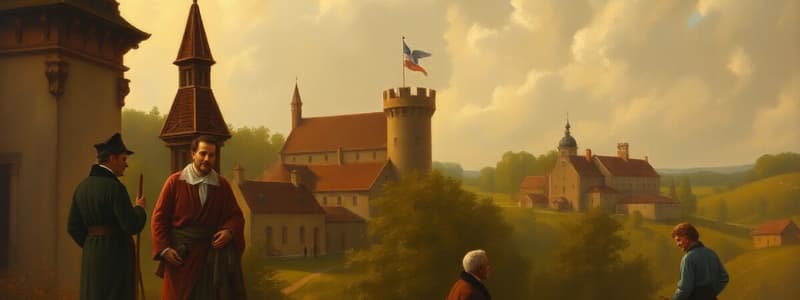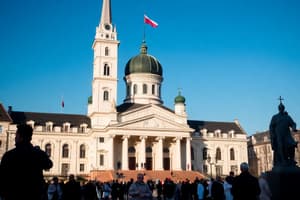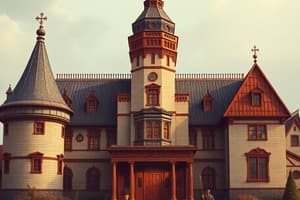Podcast
Questions and Answers
In what year was the Polish-Lithuanian Commonwealth established?
In what year was the Polish-Lithuanian Commonwealth established?
- 1648
- 1791
- 1492
- 1569 (correct)
The Polish-Lithuanian Commonwealth had a single king, parliament, and foreign policy.
The Polish-Lithuanian Commonwealth had a single king, parliament, and foreign policy.
True (A)
What was the 'Golden Liberty' (Złota Wolność) system in the Polish-Lithuanian Commonwealth?
What was the 'Golden Liberty' (Złota Wolność) system in the Polish-Lithuanian Commonwealth?
a system that gave nobles significant power and freedom
The Warsaw Confederation, signed in 1573, guaranteed religious ______ in the Polish-Lithuanian Commonwealth.
The Warsaw Confederation, signed in 1573, guaranteed religious ______ in the Polish-Lithuanian Commonwealth.
Match the ethnic/religious groups with their presence in the Polish-Lithuanian Commonwealth:
Match the ethnic/religious groups with their presence in the Polish-Lithuanian Commonwealth:
What was a significant distinction of the Polish-Lithuanian Commonwealth compared to many other European countries at the time?
What was a significant distinction of the Polish-Lithuanian Commonwealth compared to many other European countries at the time?
The Jewish community in the Polish-Lithuanian Commonwealth had no role in trade or crafts.
The Jewish community in the Polish-Lithuanian Commonwealth had no role in trade or crafts.
What was the 'kahal' in the context of the Jewish community within the Polish-Lithuanian Commonwealth?
What was the 'kahal' in the context of the Jewish community within the Polish-Lithuanian Commonwealth?
Zamość was built in the ________ style, reflecting its modern and organized design.
Zamość was built in the ________ style, reflecting its modern and organized design.
Why did Jan Zamoyski invite various groups, including Jews and Armenians, to settle in Zamość?
Why did Jan Zamoyski invite various groups, including Jews and Armenians, to settle in Zamość?
The Zamość Synagogue was built in a Gothic architectural style.
The Zamość Synagogue was built in a Gothic architectural style.
What values does the history of the Polish-Lithuanian Commonwealth and the Zamość Synagogue teach?
What values does the history of the Polish-Lithuanian Commonwealth and the Zamość Synagogue teach?
What was the role of nobles (szlachta) in the Polish-Lithuanian Commonwealth?
What was the role of nobles (szlachta) in the Polish-Lithuanian Commonwealth?
The Polish-Lithuanian Commonwealth was formed when Poland and ______ joined together.
The Polish-Lithuanian Commonwealth was formed when Poland and ______ joined together.
The 'Liberum veto' allowed any member of the Sejm to unilaterally block a decision.
The 'Liberum veto' allowed any member of the Sejm to unilaterally block a decision.
The Synagogue in Zamość is significant because it demonstrates the:
The Synagogue in Zamość is significant because it demonstrates the:
Who founded the city of Zamość, and in what year?
Who founded the city of Zamość, and in what year?
Besides Poles and Lithuanians, the Commonwealth was home to Ruthenians, Jews, Germans, Tatars, and ________.
Besides Poles and Lithuanians, the Commonwealth was home to Ruthenians, Jews, Germans, Tatars, and ________.
The Polish-Lithuanian Commonwealth was known for its religious wars and conflicts.
The Polish-Lithuanian Commonwealth was known for its religious wars and conflicts.
What made the Polish-Lithuanian Commonwealth unique?
What made the Polish-Lithuanian Commonwealth unique?
Flashcards
Polish-Lithuanian Commonwealth
Polish-Lithuanian Commonwealth
Country formed in 1569 when Poland and Lithuania joined together.
Sejm
Sejm
Parliament (government assembly) of the Commonwealth.
Szlachta
Szlachta
Ruled by nobles who had many political rights.
Golden Liberty (Złota Wolność)
Golden Liberty (Złota Wolność)
Signup and view all the flashcards
Warsaw Confederation
Warsaw Confederation
Signup and view all the flashcards
Kahal
Kahal
Signup and view all the flashcards
Liberum veto
Liberum veto
Signup and view all the flashcards
Zamość
Zamość
Signup and view all the flashcards
Zamość Synagogue
Zamość Synagogue
Signup and view all the flashcards
Study Notes
- Polish-Lithuanian Commonwealth formed in 1569 when Poland and Lithuania united
- The Commonwealth had one king, parliament (Sejm), and foreign policy
- Nobles (szlachta) ruled it and possessed many political rights
- "Golden Liberty" (Złota Wolność) gave nobles significant power and freedom
Uniqueness in Europe
- The Commonwealth permitted religious freedom during Europe's religious wars
- The Warsaw Confederation in 1573 guaranteed religious tolerance
- The Commonwealth fostered peaceful coexistence among diverse religions and cultures
Demographics of the Commonwealth
- The country was ethnically diverse, including Poles, Lithuanians, Ruthenians, Jews, Germans, Tatars, Armenians, and more
- Religions practiced included Catholicism, Orthodox Christianity, Protestantism, Judaism, and Islam
- People could speak their languages, maintain traditions, and practice their religions
The Jewish Community
- Jewish people played an important role
- They lived in cities and towns, working in trade, crafts, banking and education
- Jews had self-governance via the kahal system, managing community affairs like schools and religious courts
- It was one of Europe's most tolerant places for Jews
About Zamość
- Jan Zamoyski, a noble, founded Zamość in 1580
- The goal was for it to be a modern, beautiful Renaissance-style city
- Jews, Armenians, and other groups were invited to help Zamość grow
- The city became a trade, culture, and learning hub
Zamość Synagogue
- The Zamość Synagogue was constructed around 1610–1620
- The Synagogue featured a Renaissance design, rare for European synagogues
- Symbolizes religious freedom and respect for different cultures
- Jan Zamoyski supported the Jewish community recognizing their potential role in developing the city economically and culturally
Significance Today
- The Commonwealth exemplified multiculturalism and tolerance in Europe
- The synagogue in Zamość symbolizes how people from diverse backgrounds could live and work together peacefully
Key Terms and definitions
- Golden Liberty (Złota Wolność): Special rights and freedoms for nobles
- Sejm: The Commonwealth's parliament
- Liberum veto: The right of a noble to veto parliamentary decisions
- Kahal: Self-government for Jewish communities
- Warsaw Confederation (1573): Guaranteed religious freedom for all citizens
Quick Facts
- The Commonwealth began in 1569
- It was one of the most tolerant European countries
- People of various religions and cultures coexisted
- The Zamość Synagogue demonstrates Jewish society presence
- Jan Zamoyski invited diverse groups, contributing to Zamość's success
Studying That Suits You
Use AI to generate personalized quizzes and flashcards to suit your learning preferences.




